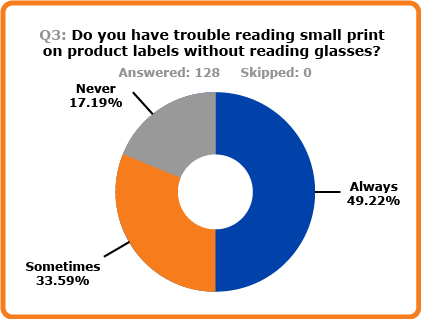IC Optix US Survey
It is an inevitable fact of life that as people age their ability to focus on near objects becomes significantly diminished. By the age of 40 most people will notice they have difficulty in focusing on near objects and by age 50 most people will need reading glasses in order to focus close-up1. IC Optix conducted a consumer survey across the US that included 128 people in the age group of 40 years old and above. The survey looked at age, vision, and the ability to read product labels. The survey also explored whether the consumer’s decision of which product to purchase, and which store to purchase product from, would be influenced by the association of a magnifier device with the product. Some of the key findings from the IC Optix survey (full survey) included:
1) 84% of those surveyed have trouble reading small print on labels
 This finding is consistent with previous studies. For example, a study conducted by the market research company Kadence International, which included 1410 people aged 40 and older, across 7 European countries, indicated that 80% of people struggled to read important text on medicine and food labels1. In the US alone there are over 140 million people that are in the age group of 40 years old and above, and it is likely that about 80% of this group (112 million people) have difficulty reading important information on product labels. This is of particular concern in the area of medications and the potential for medical error. According to a report prepared by the IOM (Institute of Medicine) medical error injures 1.5 million Americans per year and results in over $3.5 billion dollars of lost productivity, wages, and additional medical expenses. Medical error also causes about 7000 deaths per year2,3. The study indicates that 33% of the medical errors were caused by packaging and labeling issues, which includes small font size, crowded text and poor contrast.
This finding is consistent with previous studies. For example, a study conducted by the market research company Kadence International, which included 1410 people aged 40 and older, across 7 European countries, indicated that 80% of people struggled to read important text on medicine and food labels1. In the US alone there are over 140 million people that are in the age group of 40 years old and above, and it is likely that about 80% of this group (112 million people) have difficulty reading important information on product labels. This is of particular concern in the area of medications and the potential for medical error. According to a report prepared by the IOM (Institute of Medicine) medical error injures 1.5 million Americans per year and results in over $3.5 billion dollars of lost productivity, wages, and additional medical expenses. Medical error also causes about 7000 deaths per year2,3. The study indicates that 33% of the medical errors were caused by packaging and labeling issues, which includes small font size, crowded text and poor contrast.
2) 72% would use a magnifier if provided with the product
It was clear from the survey that a large majority of people would use a magnifier device if it were included with the product. The convenience of having a magnifier close at hand when using the product will increase the likelihood that the consumer will read important information on the label, thus reducing the chance of error from reading information improperly or not reading it at all.
3) 59% of respondents were more likely to choose the product having a magnifier device over a similar product without an associated magnifier if all other factors were equivalent
In addition to increasing product sales, the association of a magnifier device with the product will help ensure proper use of the product and reduce the chance of adverse outcomes and dissatisfaction with the product.
4) 43% of consumers surveyed indicated the association of a magnifier with the product would influence what store they would purchase from.
This question was included to see whether the association of a magnifier device with a product would have an influence on what store a consumer would purchase the product from. For example, if a particular chain pharmacy provided product that had an associated magnifier would this influence the consumer to purchase product from that pharmacy versus another chain pharmacy that did not offer that option.
The results from this study can be found in the full survey report conducted by IC Optix. 4
References
1. Bausch and Lomb Sight Over Forty http://www.academyofvisioncare.com/files/documents/Sight%20Over%20Forty%20-%20FINAL.pdf
2. Preventing Medication Errors: Institute of Medicine Quality Chasm Series. Washington, DC: The National Academies Press, 2007 http://www.nap.edu/catalog.php?record_id=11623
3. FDA Guidance to Industry: Safety Considerations for Container Labels and Carton Labeling Design to Minimize Medication Errors 2013
4. IC Optix Consumer Survey 2013 http://www.icoptix.com/wp-content/uploads/2014/07/IC-Optix-Consumer-Survey-070514.pdf
